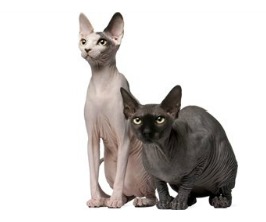
History
In 1966 a domestic cat gave birth to a hairless kitten in Toronto Canada. It was discovered to be a natural genetic mutation and the Sphynx cat, as we know it today, came into existence.
Description
The first impression of the sphynx is of an apparently hairless cat with wrinkled skin, large ears and eyes and prominent cheekbones. It is medium-sized and muscular, neither small nor dainty, and is quite warm to the touch. Males are generally larger than females
Grooming and Physical Needs
Size: Sphynx are medium sized substantial cats and not fragile in any way
- Grooming Needs: Sphynx need periodic bathing, ear and nail cleaning
- Coat Type: not totally hairless, but have a degree of hairlessness
- Moulting: very low
- Exercise Needs: very active and can entertain themselves for hours.
- Average Life Span: 20 years
- Healthcare:
Behaviour
- Family: very friendly and love to be around people, often referred to as a ‘lap cat’
- Temperament: Sphynx are extremely lovable, they have abundant energy and are mischievous, always wanting to be with you, on you or showing off for you.
- Trainability:
- Sociability (Other Pets): very good around other pets
- Meowing: known for being talkative
